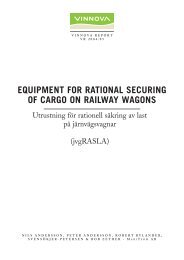Download - Autosim Autosim
Download - Autosim Autosim
Download - Autosim Autosim
Create successful ePaper yourself
Turn your PDF publications into a flip-book with our unique Google optimized e-Paper software.
THE AUTOSIM PROJECT<br />
the effective use of conventional materials as well as the development of<br />
novel materials to meet new challenges in vehicle performance and price.<br />
This will be realised chiefly through digital modelling methods.<br />
Where developments in material technology are led solely by the material<br />
suppliers there is often a delay in their introduction for use in vehicle<br />
manufacture. This can arise from uncertainty in many areas such as cost,<br />
manufacturing methods and issues such as recycling - but also,<br />
significantly, from uncertainty in how to correctly characterise these new<br />
materials for the digital model. Here, by correct characterisation, we mean<br />
the ability to describe the key characteristics of the material under the load<br />
cases of concern to generate accurate, reliable results – particularly under<br />
non-linear loading where bifurcation in results makes it essential to choose<br />
the best model from the very start of development. In many cases material<br />
properties are dependent on the manufacturing process, further<br />
complicating the ability to predict their response in the vehicle.<br />
Many parties are involved in defining materials characterisation for<br />
simulation – including the material supplier, component manufacturer,<br />
testing house, the software developer and the CAE engineer in the end user<br />
organisation. Closer collaboration will allow the benefits from new material<br />
technology to be accrued sooner. There may be a new requirement for a<br />
“CAE Material Specialist” within the automotive OEM or Tier 1 supplier; the<br />
role would include coordination of activities between the key parties,<br />
establishment and maintenance of a materials database, guidance on the<br />
effects of forming and choices of assembly methods, and how to choose the<br />
best practice material model for a particular load case. Of course, any<br />
proposal for use of a new material must also consider cost – any change in<br />
practice has to be justified in terms of cost saving and/or revenue increase.<br />
This must reflect not just the raw material cost (and availability issues) but<br />
the total cost to the enterprise – including aspects such as recycling,<br />
environmental impact, legislative restrictions and applicable manufacturing<br />
methods.<br />
A key requirement (and an area also highlighted in the confidence topic) is<br />
the need for a more powerful material database. This must provide the<br />
essential traceability but also would offer several other benefits such as<br />
controlled access to key data, support for choosing the best material,<br />
guidance on which parameters are needed for specific load cases,<br />
automatic updates via PDM/SDM systems, and simply avoiding wasted time<br />
searching for or re-generating missing data. Such a system will eventually<br />
need to include probability-based definitions of material properties.<br />
A clearly defined materials characterisation methodology would permit new<br />
materials to be adopted with increased confidence. The methodology<br />
SIXTH FRAMEWORK PROGRAMME PRIORITY [6.2] [SUSTAINABLE SURFACE TRANSPORT]<br />
012497 AUTOSIM<br />
49 |
















